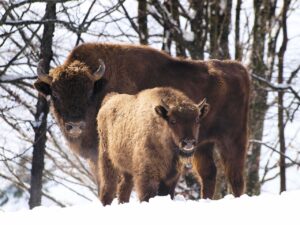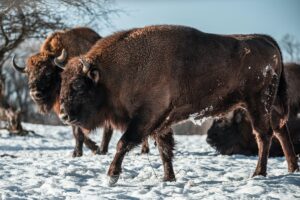The European bison once roamed forested mountains across the continent before hunting and habitat loss decimated herds. By the 1920s only 54 bison remained, narrowly dodging extinction in zoos. Thanks to careful breeding programs, these iconic giants slowly recovered but still require active conservation today.
Revered and Reviled
Towering up to 6 feet tall and weighing over a ton, the wild European bison holds title as the continent’s largest land mammal. Yet humans nearly loved the imperfect gentle giants to oblivion.
Long revered as a spiritual symbol of strength and featured in cave paintings, bison later became reviled as “king of the forest” competing with hunters and forestry interests. Vast numbers were slaughtered through the 1800s until only the small zoo herd persisted.

Narrow Escape from Oblivion
By World War I, the last wild European bison population was wiped out in the Caucuses mountains. Only 54 zoo bison across Europe remained, narrowly escaping total extinction. But with no sustainable breeding population, captive groups were functionally extinct and needed intervention for species survival.
In 1923 Poland founded the first European bison reintroduction at Białowieża Forest followed by others sites in Eastern Europe. Meticulous breeding slowly grew captive numbers to 2500 across 30 locations by the 1950s. The species clung to fragile repopulation until remotely released herds gradually stabilized wild numbers around 3000 today.
Ongoing Conservation Needs
While more viable, the European bison’s conservation status remains vulnerable. Harsh winters and disease periodically threaten populations as in Poland’s Bieszczady National Park where numbers dropped 50% by 2018. Habitat loss and small isolated populations elevate extinction risk long-term without active management.
Cautious relocations seek to build interconnected populations across the Carpathians. Supplemental winter feeding sustains free-roaming herds through food shortages in harsh climates. Białowieża forest, one of Europe’s last old growth woodlands, protects the largest population as a UNESCO heritage site.

As keystone herbivores, European bison benefit biodiverse forests through grazing and seed dispersal. Their return helps restore degraded ecosystems across central Europe by creating light gaps and cultivating grasslands. Bison wallows even help amphibians by collecting rainwater for breeding.
Seeing the woolly gentle giants roam freely again inspires hope after narrowly cheating vanishing fate. But natural comeback depends on expanding habitat and herd connectivity. Safeguarding the continent’s largest living land animal ensures their thundering hooves reshape forests for generations to come.









